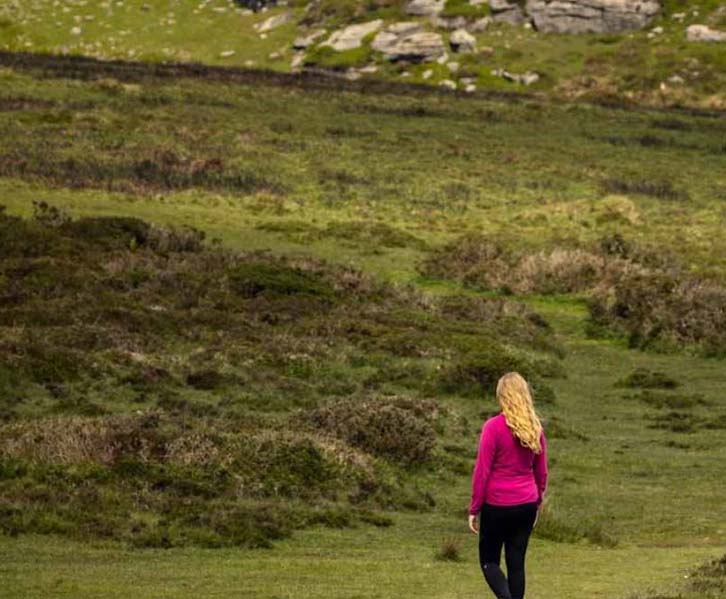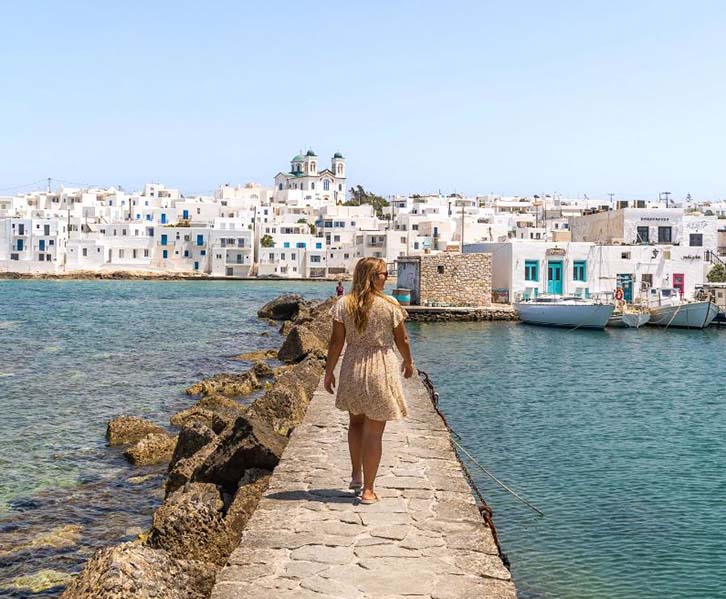Devon, often overshadowed by its neighbor Cornwall, deserves a spot on your UK travel bucket list. This stunning county in Southwest England offers a diverse array of attractions and natural beauty.
Devon has it all: bustling seaside towns, serene countryside, two magnificent national parks, charming villages, rich wildlife, a thriving culinary scene, and much more.
With both northern and southern coastlines, you’ll find a variety of coastal activities, from thrilling water sports and scenic cliff hikes to pristine beaches catering to all preferences. Don’t miss these enchanting destinations in Devon!
Top Destinations to Explore in South Devon
Dartmouth
Nestled along the western bank of the expansive Dart Estuary, Dartmouth boasts a rich maritime history as a prominent port on the southern coast of England. The town is home to an esteemed naval college, an upscale yacht marina, and a charming historic harbor district.
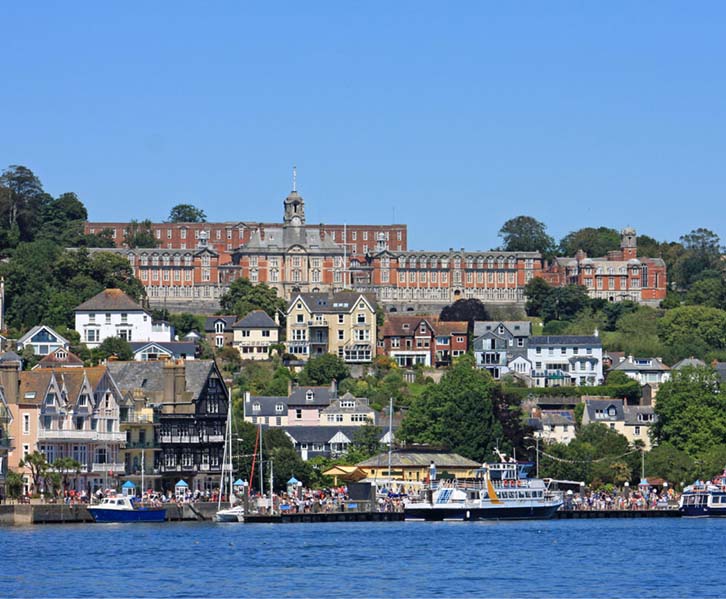
In the present day, Dartmouth’s winding streets are lined with picturesque old structures that host upscale dining establishments, inviting pubs, stylish art galleries, and trendy boutiques. It’s also a hub for nautical clothing shops, truly embracing its maritime heritage.
A standout feature of Dartmouth is the delightful river exploration it offers. Embark on a scenic ferry ride downstream to visit Dartmouth Castle, parts of which have stood since 1388. Then, opt for a leisurely river cruise in the opposite direction to observe the local wildlife, including seals, kingfishers, various wading birds, and occasionally even otters.
Plymouth
Plymouth, the largest city in Devon, boasts a vibrant maritime legacy, earning it the moniker ‘Ocean City.’ This port has been the departure point for numerous iconic voyages throughout history, including those of the Mayflower Pilgrims, Captain James Cook, and Francis Drake.
In recent years, Plymouth has been experiencing a significant revitalization. The city, which suffered extensive bombing during World War II because of its strategic naval port, hastily reconstructed its city center with a focus on functionality over aesthetics.
However, the cityscape is evolving with the development of stylish new waterfront projects around Sutton Harbour and Royal William Yard, along with the emergence of an exciting Arts Quarter.
Burgh Island
You can’t miss out on Burgh Island when exploring South Devon – this iconic landmark offers a fantastic mini adventure! This tidal island is linked to the mainland by a narrow beach strip that vanishes completely during high tide.
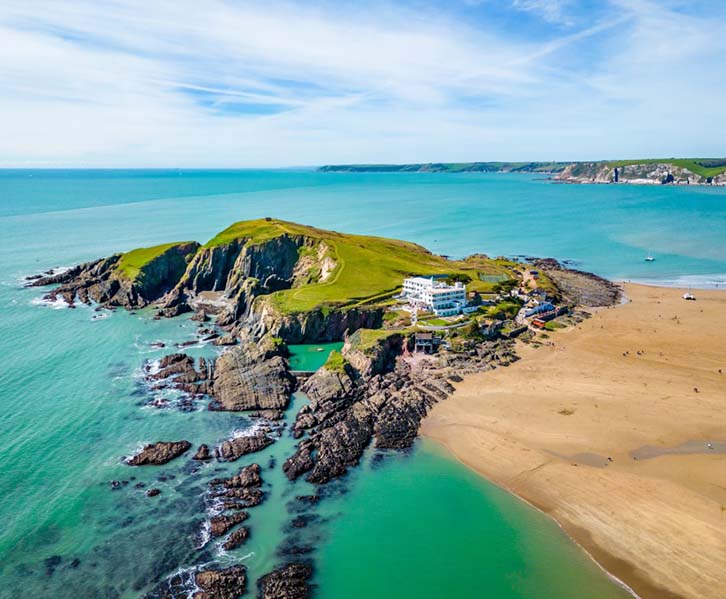
During low tide, you can easily walk to Burgh Island from Bigbury-on-Sea. Alternatively, during high tide, you can take the Sea Tractor, a unique and peculiar-looking vehicle operated by Burgh Island Hotel. Timetables for the Sea Tractor can be found at the beach carpark in Bigbury-on-Sea and at the island’s entrance.
Burgh Island is sparsely populated, with only a few buildings and no proper roads. It’s the perfect place to escape from the hustle and bustle of everyday life. Here, you can hike along the coast path, observe wildlife, and climb the hill for panoramic coastal views. When it comes to dining, you have the option of the stylish art deco Burgh Island Hotel or the historic 14th-century Pilchard Inn, one of England’s oldest taverns, known for its tales of a ghostly smuggler.
Salcombe
Located a short distance from Dartmouth along the coast, you’ll discover yet another sailing haven to visit. Nestled at the entrance of the tranquil Kingsbridge Estuary, Salcombe stands as one of the more upscale destinations in South Devon.
This charming town, with its picturesque moorings, pristine sandy beaches, and high-end dining options, tends to draw a yachting crowd. Nevertheless, there’s something for everyone to relish here.
Be prepared for a culinary journey featuring outstanding seafood (be sure not to overlook the Crab Shed), as well as breathtaking cliffside hikes and exquisite beaches. The nearest options include South Sands and North Sands, or you can opt for a ferry ride to discover the idyllic beaches around East Portlemouth on the opposite shore.
Torquay & The English Riviera
During the era of the Napoleonic Wars (1803-1815), the trio of towns nestled around the expansive and magnificent Tor Bay became affectionately known as ‘The English Riviera.’ As the French Riviera was inaccessible due to the ongoing conflicts, affluent Georgians sought solace and relaxation in the tranquil and sheltered waters of Tor Bay.
Torquay and Paignton stand as the two most prominent towns in the area. Each of them boasts delightful beaches and exudes a sense of nostalgic seaside charm. For those seeking a quintessential English seaside experience, this region is an ideal destination.
Torquay, with its grand Victorian villas and picturesque parks, offers a more upscale ambiance. On the other hand, Paignton adopts a more “budget-friendly and cheerful” atmosphere, with some areas showing signs of wear and tear. Nonetheless, Paignton is home to some beautiful beaches, such as Goodrington and Broadsands, and features a retro Victorian pier adorned with funfair rides and arcades.
Brixham
Brixham, located within the English Riviera, offers a distinctive atmosphere compared to Torquay and Paignton. This charming fishing village has its own unique character and ambiance.
In this picturesque village, you’ll discover vibrant fishermen’s cottages nestled on a hillside overlooking a bustling, operational harbor. Brixham boasts one of the UK’s largest fishing fleets, making it a seafood lover’s paradise. Be sure to visit Rockfish for some of the finest sustainable seafood in the region!
Explore Dartmoor National Park
Devon’s beauty extends beyond the south coast, with numerous remarkable destinations in its picturesque rural heart. One of my personal favorites is Dartmoor National Park.
Dartmoor National Park is a vast wilderness characterized by its heather-covered moors and striking granite tors – hilltop rock formations. The park offers a diverse landscape that includes ancient woodlands, dense pine forests, and deep gorges, making it the ideal setting for outdoor adventures such as hiking, biking, horseback riding, rock climbing, and caving.
Be sure to explore the charming village of Widecombe-in-the-Moor, visit the ancient Bronze Age settlement at Grimspound, and take in the iconic Haytor Rocks, a fantastic location for a leisurely walk. Another great experience is the walk along the old Princetown Railway to King’s Tor, where you can discover the historic Foggintor Quarry.
Totnes
Located in the picturesque countryside of South Devon, Totnes holds the honor of being the United Kingdom’s inaugural Transition Town, making it one of the most ethically conscious towns in England. As one of the pioneering communities in The Transition Network, a global initiative focused on addressing global challenges at the grassroots level, Totnes is committed to creating a sustainable and resilient future.
This has fostered a vibrant, community-driven atmosphere with a highly independent high street that offers a diverse range of shops and businesses. Totnes also boasts a thriving vegetarian and vegan food scene, with Riverford Field Kitchen serving up a delightful farm-to-fork dining experience.
Besides its culinary delights, Totnes is steeped in history, with notable landmarks like the ancient Totnes Castle. The town is further enriched by the tranquil and wildlife-abundant River Dart, as it sits at the head of the Dart Estuary. Visitors can embark on ferry rides and boat tours to Dartmouth or opt for kayaking and stand-up paddleboarding adventures to explore the scenic waterways.
Best Places to Visit in East Devon
Exeter
The charming city of Exeter, Devon’s capital, graces the riverbanks and is steeped in captivating history. Its origin traces back to Roman times, and the town center proudly displays remnants of the ancient Roman city walls. These historical layers harmoniously coexist with Norman, Medieval, and Tudor buildings, characterized by their distinctive gabled architecture.
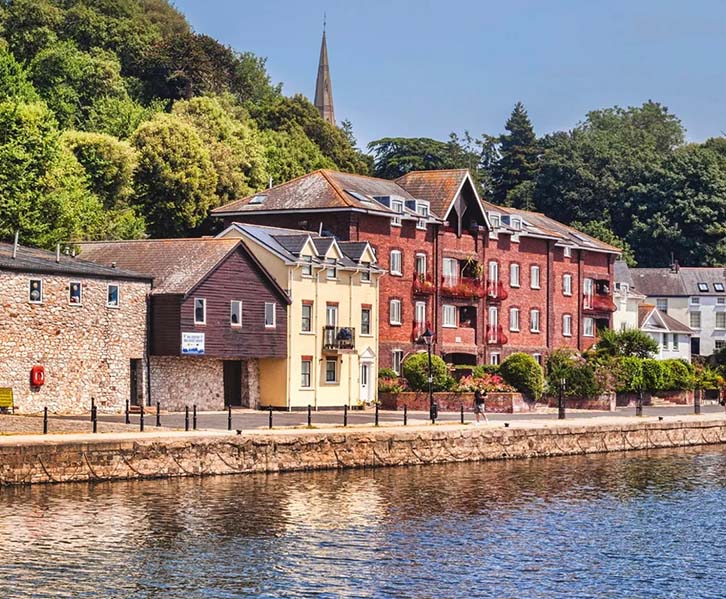
A must-visit in Exeter is the magnificent Exeter Cathedral. This architectural masterpiece traces its origins back to 1114 and underwent extensive rebuilding during the 13th and 14th centuries. A true marvel is the ornate medieval image screen that adorns the cathedral’s façade, adorned with intricately carved figures.
Throughout its history, life in the city has revolved around the River Exe, a tradition that endures to this day. While Exeter Quay once bustled as a bustling trade port, facilitating the transportation of goods down the river to the sea at Exmouth, it has since transformed into a scenic riverside leisure destination. Here, you’ll find a delightful array of restaurants, bars, and independent shops nestled within the repurposed warehouse cellars.
Exmouth
Situated just downstream from Exeter, the charming and vibrant coastal town of Exmouth serves as the gateway to the renowned Jurassic Coast.
Exmouth is most renowned for its expansive sandy beach, modern marina, ideal conditions for various water sports, and the picturesque coastal cliffs. However, the serene river valley surrounding the town also offers breathtaking countryside landscapes for hiking and biking enthusiasts, featuring an abundance of scenic trails.
Moreover, the Exe Estuary is a thriving hub for wildlife enthusiasts, with opportunities to spot grey seals, otters, and a variety of wading birds, including oystercatchers, lapwings, and avocets.
Jurassic Coast
The Jurassic Coast spans 95 miles along the coast of Devon and Dorset and is celebrated for its distinctive geology and geography, featuring a wealth of prehistoric rocks and fossils. The red sandstone cliffs of East Devon, which date back to the Triassic period (252-200 million years ago), represent the oldest section of this remarkable coastline.
The official starting point of the coastline is identified by the Geoneedle at Orcombe Point, and it extends from Exmouth to Studland Bay in Dorset. The Devon segment of the coastline concludes at Lyme Regis, and noteworthy highlights along this stretch between Exmouth and Lyme Regis comprise:
- Ladram Bay – a serene cove characterized by imposing, rust-colored rock formations, with the dominant presence of High Peak, a towering cliff.
- Straight Point – a petite headland recognized for its abundant seabird colonies, notably a substantial kittiwake population.
- Beer Quarry Caves – offering guided tours of a 2,000-year-old quarry, originally established by the Romans and remaining active until the 1920s. Visitors can observe extensive pick axe marks on virtually every surface, attesting to the quarry’s primarily manual excavation.
Seaton and Beer
Seaton, a charming coastal town, features an extensive pebble beach, historic architectural gems, and the thriving Seaton Wetlands Nature Reserve, teeming with wildlife.
What truly sets this place apart as one of the top destinations in Devon is the historic Seaton Tramway, featuring a collection of meticulously restored electric trams hailing from the 1940s-1960s. These trams travel along the former Seaton branch line, originally used to transport Victorian vacationers to the seaside. For excellent Wetlands views, you can choose the top deck when taking the short journey to Colyton.
Adjacent to Seaton, the picturesque hillside village of Beer offers yet another delightful pebble beach set against towering white cliffs. Renowned for its Quarry Caves, as mentioned earlier, Beer boasts a vibrant fishing heritage. Visitors can purchase fresh fish and locally caught Beer crab directly from fishermen, or even partake in fishing excursions to try their hand at angling.
Sidmouth
Sidmouth, too, stands as a charming historic seaside resort adorned with splendid Regency and Victorian-era architectural gems. Embark on the Blue Plaque Trail, a journey unveiling more than 60 heritage buildings, which encompasses iconic structures like the Royal York Hotel, constructed in 1807, and the castle-like clock tower gracing Connaught Gardens.
Jacob’s Ladder is the premier beach in the vicinity, earning its name from the historic wooden staircase that gracefully descends from the cliff’s pinnacle to the beach below.
Best Places to Explore in North Devon
Exmoor National Park
Exmoor offers a plethora of adventures for outdoor enthusiasts, including mountain biking, hiking, horse riding, wild swimming, and stargazing. To maximize your chances of encountering Exmoor’s wildlife, I strongly recommend embarking on a jeep tour with Exmoor Wildlife Safaris. This guided experience not only offers fantastic wildlife encounters but also provides an opportunity to explore the park with a knowledgeable local guide.
Be sure to visit Tarr Steps, a straightforward yet impressive “clapper bridge,” holding the distinction of being the longest of its kind in Britain. The area is surrounded by a picturesque nature reserve.
Ilfracombe
Ilfracombe is the largest coastal town in North Devon and serves as an excellent starting point for exploring the surrounding region. The town’s origin is tied to its well-protected natural harbor, and to this day, it boasts a lively fishing industry. Consequently, you’ll find a variety of outstanding seafood restaurants in the town!
Embark on a boat tour to observe seals and seabirds while gaining insights into the area’s coastline. I personally enjoyed the exhilarating RIB ride with Ilfracombe Sea Safari, but for a more tranquil experience with fantastic views, you can opt for the Ilfracombe Princess, a bright yellow vessel with a top deck.
A must-visit attraction is the distinctive Tunnels Beaches. These small coves, featuring Victorian bathing pools, are accessed by strolling through a hand-carved stone tunnel in the cliffs, dating back to 1823. You can still spot the pickaxe marks on the tunnel’s walls!
Lundy Island
Lundy Island, located in the Bristol Channel, is a secluded and windswept island boasting a vibrant population of Atlantic grey seals. With fewer than 30 full-time residents and minimal infrastructure, Lundy Island is teeming with wildlife. You can observe seals basking on the beaches, puffins and various seabirds perched on the cliffs, and encounter hardy Lundy ponies and wild goats along the clifftop trails.
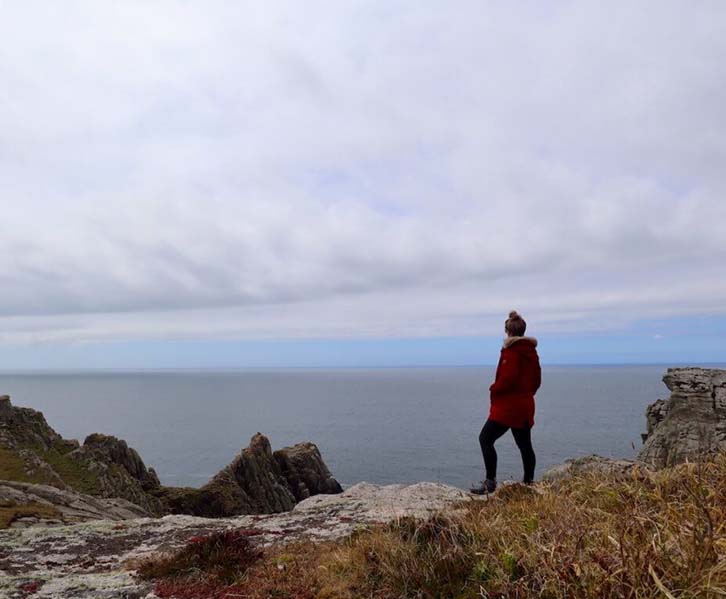
You can choose to embark on a day trip to Lundy or extend your stay for a more immersive and adventurous getaway. Accommodation options include a campsite and several self-catering properties, all managed by the Landmark Trust.
To reach the island, you can board the MS Oldenburg, a ferry dating back to the 1950s, operating from March to November. Departure times and locations may vary based on the tide, with possible departure points in Ilfracombe or Bideford, so it’s advisable to review the timetable here before planning your visit. The ferry ride typically lasts around 2 hours and can sometimes be quite choppy – they often provide motion sickness bags as you board. Nevertheless, the experience is well worth it!
Hartland Peninsula
The Hartland Peninsula, situated at the westernmost tip of North Devon’s coastline, offers further opportunities to observe seal colonies and explore its rugged cliff paths.
The Hartland Peninsula, although often overlooked, is a small and charming piece of land adorned with picturesque villages and small woodlands. It boasts some of the most stunning coastal walks in Devon, featuring challenging segments of the South West Coast Path. Be sure to bring binoculars to spot seals on the beaches around Hartland Point while you traverse the cliff paths.
Clovelly
Clovelly Historic Village is often considered one of the most picturesque villages in Devon, and perhaps even in all of Southwest England. This charming hillside village is adorned with white-washed cottages perched above a serene and sheltered harbor, creating a truly breathtaking sight.
The entire village serves as a tourist attraction, and there is an admission fee for entry. However, this fee covers parking, access to both museums, and admission to the nearby Court Gardens.
Within the village, steep cobbled lanes wind their way downhill, bordered by charming cottages and quaint craft shops. Due to their narrow and steep nature, these lanes are inaccessible to cars, rendering Croyde a pedestrian-only village, which enhances its overall tranquility.
Croyde
Croyde is the epicenter of North Devon’s surfing scene. This bay is renowned for its exceptional surfing conditions, with numerous surf schools and rental shops available in the village. The neighboring Saunton Sands, Woolacombe Beach, Putsborough, and Barricane Beach are also well-liked surfing destinations.
It’s not solely about surfing; Croyde is a charming seaside village boasting one of Devon’s most exquisite beaches. This small, crescent-shaped bay features golden sands framed by grassy dunes. Additionally, the village boasts a vibrant independent food scene, with numerous food trucks and pop-ups gracing the beach during the summer months.
Lynton and Lynmouth
The paired villages of Lynton and Lynmouth, situated on the coast within Exmoor National Park, are linked by a Victorian-era Cliff Railway, which is reputed to be the world’s tallest and steepest entirely water-powered funicular. This exhilarating ride is surprisingly speedy and offers breathtaking views of the coastline.
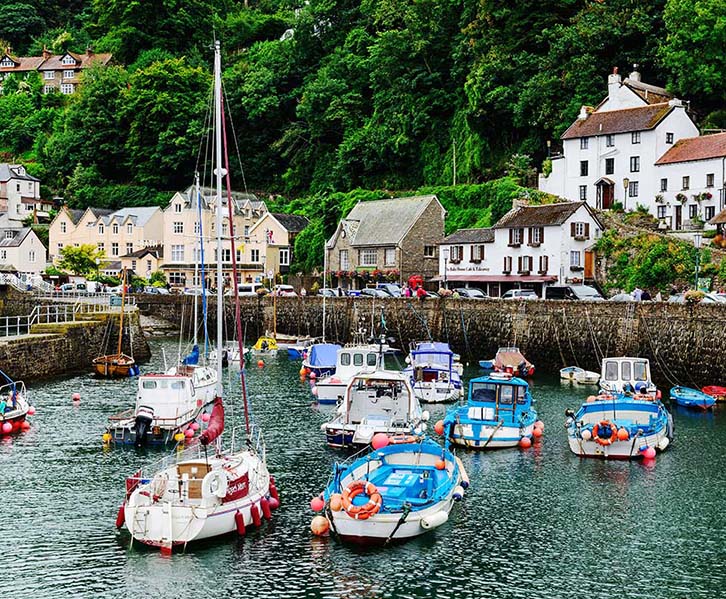
Lynton is perched atop the cliff, bustling with independent shops, art galleries, and several museums. Down below, some 500 feet lower in the gorge, you’ll find Lynmouth, which features a charming harbor, fantastic seafood dining options, and the United Kingdom’s inaugural tidal current turbine located at Glen Lyn Gorge.
Taw-Torridge Estuary
On the coastline between Saunton Sands and the well-loved seaside destination of Westward Ho!, you’ll find a spacious estuary where the River Taw and River Torridge converge before flowing into the sea. It’s a stunning, wildlife-rich region and a somewhat undiscovered treasure in North Devon, so be sure to explore it.
On either side of the estuary, you’ll discover two extensive sand dune systems: Braunton Burrows and Northam Burrows. Both serve as excellent spots for birdwatching and are teeming with local wildlife, including orchids, butterflies, and vibrant green sand lizards.
You can enjoy some wonderful riverside walks in the region, or begin your journey along the 180-mile Tarka Trail, a charming, vehicle-free cycling route. Make sure to pay a visit to the picturesque fishing village of Appledore, where you’ll find streets adorned with pastel-painted cottages that are perfect for Instagram-worthy snaps.
